- News
- Reviews
- Bikes
- Components
- Bar tape & grips
- Bottom brackets
- Brake & gear cables
- Brake & STI levers
- Brake pads & spares
- Brakes
- Cassettes & freewheels
- Chains
- Chainsets & chainrings
- Derailleurs - front
- Derailleurs - rear
- Forks
- Gear levers & shifters
- Groupsets
- Handlebars & extensions
- Headsets
- Hubs
- Inner tubes
- Pedals
- Quick releases & skewers
- Saddles
- Seatposts
- Stems
- Wheels
- Tyres
- Tubeless valves
- Accessories
- Accessories - misc
- Computer mounts
- Bags
- Bar ends
- Bike bags & cases
- Bottle cages
- Bottles
- Cameras
- Car racks
- Child seats
- Computers
- Glasses
- GPS units
- Helmets
- Lights - front
- Lights - rear
- Lights - sets
- Locks
- Mirrors
- Mudguards
- Racks
- Pumps & CO2 inflators
- Puncture kits
- Reflectives
- Smart watches
- Stands and racks
- Trailers
- Clothing
- Health, fitness and nutrition
- Tools and workshop
- Miscellaneous
- Buyers Guides
- Features
- Forum
- Recommends
- Podcast
TECH NEWS
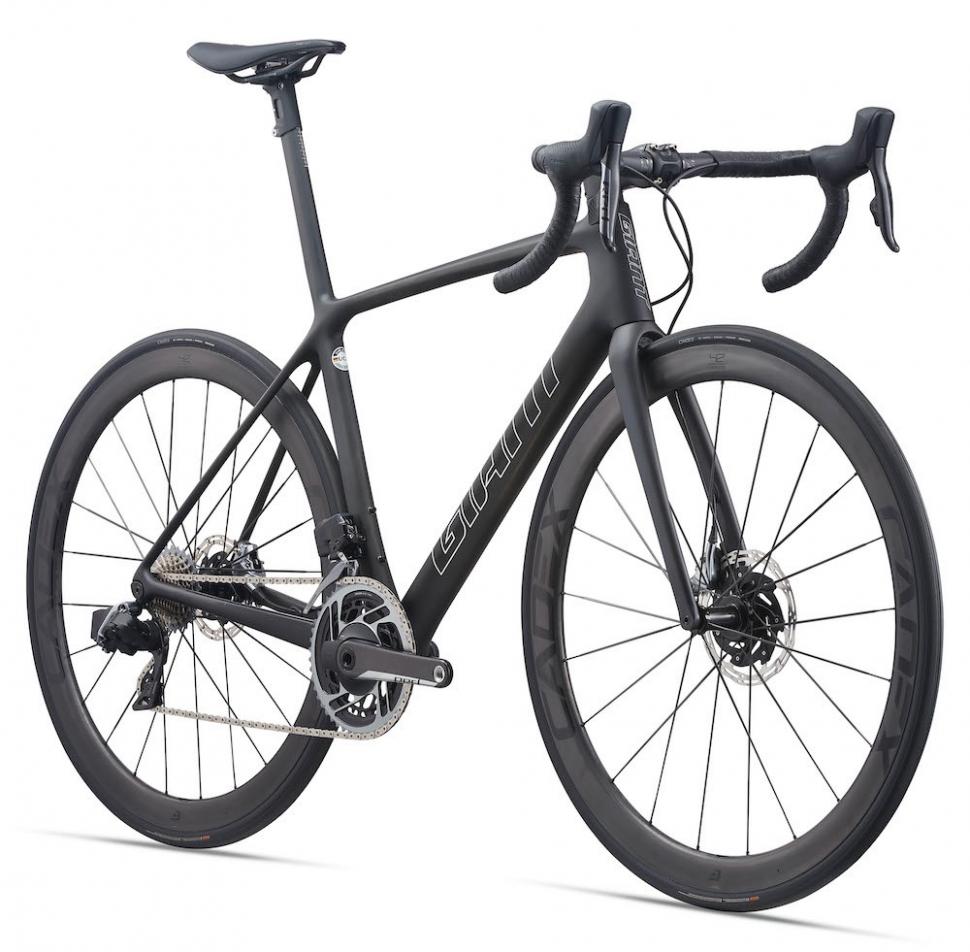 2021 Giant TCR Advanced SL 0 Disc studio.jpg
2021 Giant TCR Advanced SL 0 Disc studio.jpgGiant launch 2021 TCR Advanced – the “fastest TCR ever”
Giant has revealed its new 2021 TCR bikes and says that they are lighter, stiffer and more aerodynamically efficient than ever before, with the top-level Advanced SL models offering the highest stiffness-to-weight ratio in their class.
In performance terms, the main idea behind this, the ninth generation, is that the TCR climbs as well as ever while being faster to descend and sprint.
Here's the news in short:
• Increased stiffness-to-weight ratio
• Frame now aero optimised
• Wider tyre clearance
• Geometry is virtually unaltered
• No Shimano Dura-Ace complete bike, for now
• Top model electronic shifting only
Let's go through the key characteristics in turn.
Stiffness-to-weight ratio
"Stiffer", "lighter"... we've heard those claims from many brands a million times before. Here's how Giant makes its case...
"A high stiffness-to-weight ratio is a hallmark of the TCR," says Giant. "To retain this critical advantage, new cutting-edge composite materials, laser-cut composite swatches and advanced robotic layup techniques have been used to create best-in-class torsional and pedalling stiffness, giving it a livelier ride quality, explosive acceleration and improved climbing efficiency."
Read our First Ride impressions of the Giant TCR Advanced SL 0 Disc here
We'll come back to some of those details in a mo. First, a few figures. Giant gives this weight comparison between the 2021 TCR Advanced SL Disc and the 2020 version:
| 2020 TCR Advanced SL Disc | 2021 TCR Advanced SL Disc | Change | |
|---|---|---|---|
| Frame | 818g | 765g | -53g |
| Fork | 331g | 330g | -1g |
| Cone | 7.19g | 3.64g | -3.55g |
| Spacer | 14.37g | 19.59g | +5.22g |
| Top cap | 15.6g | 6.6g | -9g |
| ISP clamp | 118g | 103.9g | -14.1g |
| Paint | 125g | 60g | -65g |
Total weight savings 140.43g
Giant gives a frameset weight (painted frame, painted uncut fork, integrated seatpost, seat clamp, front and rear derailleur hangers) of 1,265g.
In developing the top-end TCR Advanced SL Disc, Giant set out to create a stiffness-to-weight ratio higher than that of three key rivals:
• Specialized S-Works Tarmac Disc
• Trek Emonda SLR Disc
• Cervelo R5 Disc
Each of these bikes is a lightweight all-round race bike with aero features (not the full-on aero road bike in their respective ranges) and Giant says that its new TCR Advanced SL Disc outperforms the lot in terms of stiffness-to-weight... Of course! It would hardly shout about a comparison with another bike if it came out second best.
The stiffness has been measured following the protocols of Germany’s Tour Magazine, which have been widely adopted within the bike industry. Frame stiffness and fork stiffness are measured separately and the figures combined.
Giant says that the new TCR Advanced SL Disc is stiffer than any of those three rivals mentioned above. The Trek Emonda SLR Disc is slightly lighter (by 17g) but Giant says that the stiffness-to-weight of its own bike is considerably greater.
Here's Giant's comparison between the stiffness and weight of the four bikes:
| Giant TCR Adv SL Disc | Specialized S-Works Tarmac Disc | Trek Emonda SLR Disc | Cervelo R5 Disc | |
|---|---|---|---|---|
| Transmission stiffness (N/mm) | 149.8 | 135 | 110.4 | 124.9 |
| Frameset weight (kg) |
1.27 | 1.37 | 1.25 | 1.59 |
| Stiffness-to-weight | 118 | 98 | 88.3 | 79 |
Part of the TCR Advanced SL's stiffness-to-weight gain is said to be down to an upgrade in materials. Whereas 30% of the carbon-fibre used is Toray T800, as before, the remaining 70% is a new higher modulus filament that's stiffer and lighter. Giant produces everything in-house, right down to the carbon-fibre used.
The previous generation TCR Advanced SL was made from 360-380 swatches of carbon fibre that were 'cookie cut' to shape. That method is what it sounds like: a sheet of carbon has a cutter pressed onto it to produce the individual swatches. Someone then arranges these swatches in a mould.
Each new TCR Advanced SL frame is made from over 500 swatches that are laser cut to size, which is a more accurate system that allows tighter tolerances.
About 150 of the smallest swatches for the TCR Advanced SL are now laid up by robot (which is tech that's not used for the more affordable options). Again, this allows for greater precision meaning that less material can be used, hence a lower weight.
More weight is saved in the paint process. Seven or eights layers of paint is the norm but Giant has cut that to just three. This ThinLine Finishing Technology accounts for a saving of about 65g across the frame and fork.
We have a top-level TCR Advanced SL Disc 0 here at road.cc for test, ML sized and built up with a SRAM Red eTap AXS groupset (including a powermeter) and Cadex 42mm Disc Tubeless wheels, and it hits our scales at 6.69kg.
As usual, Giant divides its TCR range into three different levels (more on the differences down below): TCR Advanced SL, TCR Advanced Pro, and the TCR Advanced.
The TCR Advanced Pro and the TCR Advanced use exactly the same frame, made from Toray T700 carbon-fibre, as previously.
The new TCR Advanced Pro Disc frameset (above), plus the handlebar and stem, is now 131.6g lighter than the previous generation, 72g of that reduction coming from the frame and fork.
The new TCR Advanced Disc frameset is a whopping (it's all relative!) 214g lighter than the previous model. More than half of this saving comes from swapping from an aluminium steerer tube to a carbon one.
Aerodynamics
Giant hasn't incorporated aerodynamic features on its TCR before, figuring that if you want to reduce drag you'll opt for one of its Propel aero road bikes, but that has all changed this time around.
"The new TCR takes a major leap forward in aero performance," says Giant. "This is where its most quantifiable gains, compared to the previous generation, can be found.
"Every tube shape was analysed, engineered and tested to create an overall structure with significantly lower drag at a wider range of yaw angles. The result is a TCR that’s faster than ever, especially in sprints and solo efforts."
As is often the case on bikes of this kind, the tube profiles are truncated ellipses – the leading edge and sides are designed to reduce drag while the trailing edge is cut off square to reduce weight and avoid handling issues in crosswinds.
That shaping is obvious when you look at the head tube although, as mentioned above, the oversized steerer and bearings have been retained for stiffness.
The shaping of the down tube on all versions of the TCR is designed to work with a water bottle in place on the basis that nearly everyone ride with a bottle most of the time. We've measured that tube at 65mm across at the widest point – up from 54mm – which is about as wide as possible without infringing on the drivetrain.
The fork and seatstays are now symmetrical and more open, the idea being to allow greater airflow efficiency plus increased tyre clearance (see below).
As is pretty much standard practice, the aerodynamic development was undertaken on computer with validation taking place in the wind tunnel, in this case the GST wind tunnel in Immenstaad, Germany (which road.cc has visited many times, with Swiss Side and Hunt, for example).
Giant conducted its tests with spinning wheels, two bottle cages and bottles fitted to the bike, and a dynamic mannequin (with moving legs) in the saddle to mimic real-world conditions. Tests were conducted at 40km/h (25mph) – so a fast but not unrealistic racing speed – and with yaw angles from -15° to +15°.
Giant says that its testing proves that the new TCR Advanced SL Disc is more aerodynamically efficient than any of the three rival bikes mentioned previously: the Trek Emonda SLR Disc is 13.9% less aerodynamically efficient, the Specialized S-Works Tarmac Disc is 0.5% less, and the Cervelo R5 Disc is 0.4% less. Again, these are Giant's own figures and it's very possible that the other manufacturers will dispute the findings.
| Giant TCR Adv SL Disc | Specialized S-Works Tarmac Disc | Trek Emonda SLR Disc | Cervelo R5 Disc | |
|---|---|---|---|---|
| Average drag (watts) | 247.5 | 248 | 261.4 | 247.9 |
| Difference (watts) | -0.5 | -13.9 | -0.4 |
Giant's tests demonstrate that the new TCR is significantly quicker than the previous version, saving 34secs over 40km (25 miles) at 200 watts of pedalling power.
Giant could have gone further in terms of aerodynamics by incorporating deeper tube shapes, but that would have affected weight. Although the tubes have changed shape considerably, the circumferences are about the same as before, which is why there has been no increase in weight.
Giant could also have increased the level of integration, but the design brief was to keep the bike useable, easy to adjust and simple to transport.
Tyre clearance
Many brands have increased tyre clearance even on their full-on race bikes recently, and Giant is no exception. You can now run 32mm tyres from most brands on the disc brake bikes in the new TCR range.
The maximum tyre width you can use on the rim brake models is 28mm, but that's down to the calliper rather than the frame/fork.
Integrated seat post
As previously, each of the Giant TCR Advanced SL bikes comes with an integrated seatpost (ISP; the seat tube extends well beyond the top tube junction and is topped by a clamp for the saddle) that you cut to length, while the more affordable options get a standard-style seatpost, albeit aero shaped.
Every TCR Advanced SL comes equipped with a standard clamp that offers 25mm of up/down adjustability, and a long clamp with 45mm of adjustability.
The standard clamp now comes with a carbon composite cradle to save weight, although the longer one still has an aluminium cradle.
The longer clamp has two uses: it gets you out of trouble if you cut the integrated seatpost too low, and it allows you to sell the bike on to someone who needs to set the saddle higher than you.
Geometry
Giant hasn't altered the geometry of the TCR radically although the bottom bracket drop is now 2mm less than before in order to accommodate larger tyres. Other measurements have been tweaked so that stack, which is measured from the centre of the bottom bracket, remains the same.
One other difference is that Giant has slightly altered the geometry of the ML model (which sits between medium and large). Previously, the effective top tube for medium was 550mm, ML was 570mm and large was 580mm. Now it's 565mm for the ML model, exactly halfway between the other two.
Other features
Giant has been concentrating hugely on its own component range over the past few years – both Giant and Cadex branded – and there's some real quality included on the TCR bikes now.
The top-level Giant TCR Advanced SL 0 Disc, for instance, comes with an ultralight Cadex 42mm Disc Tubeless WheelSystem with rims made from Toray T800 carbon-fibre, which is the same material that's used for 30% of the frame, and carbon composite spokes. Giant says that there's 69% less internal drag in the hub than in a DT Swiss 240.
Other models in the range feature Giant's updated SLR 1 (with the same hub internals as the Cadex 42mm Disc mentioned above) and SLR 2 wheels with hookless 42mm-deep carbon rims that are wider than previously (23mm outer width; 19.4mm inner width compared to 17mm before) and optimised for high-volume tyres. Giant says that this results in a rounder shape for better cornering stability and control.
"The new rims are produced using an innovative layup process that strategically positions carbon-fibre materials to increase strength and durability at a minimum weight," says Giant.
"The wheels also feature Dynamic Balanced Lacing (DBL) and low-friction hubs for superior efficiency and reduced rolling resistance."
As you'd probably expect, 25mm width tyres are fitted as standard.
The TCR range also includes new Giant Fleet and Approach saddles. Both the Fleet SLR and Fleet SL follow current trends in being wide with a short nose.
Check out 8 of the best short saddles
All Fleet and Approach saddles feature Giant's Particle Flow technology designed to dissipate pressure and prevent numbness. The idea is that free-flowing particles in two separate pockets within the saddle mould to your shape to keep you comfortable.
The TCR bikes feature all-new Giant Contact SLR and SL stems and handlebars. The bars have a new profile that's a fairly similar to that of many of the frame tubes, although this is as much about ergonomics as it is about aerodynamics.
The TCR Advanced SL and TCR Advanced Pro bikes come with a new out-front computer mount that'll take a computer from Garmin, Wahoo or Giant. Both the angle and the reach are adjustable.
The TCR range features revised gear cable routing and the front brake hose goes through the fork leg on all disc models.
If you go for Shimano's Di2 electronic shifting, the cable enters the frame through the brake hose port with a dedicated rubber grommet, and a bar-end junction box used.
The TCR Advanced SL Disc frame is electronic shift only.
Disc brake models throughout the TCR range feature a new thru-axle design with a removable composite lever – one per bike. It's held in the axle by a rubber O-ring plus a magnet. You can either ride with it in place, stow it in your pocket, or leave it at home and use a 5mm hex key if you need to take a wheel off. We've seen similar from other brands.
TCR Advanced 2021 model lineup
As usual with Giant, the range is divided into three different frameset levels, each containing various different builds. Here's what Giant says about each:
• TCR Advanced SL/ TCR Advanced SL Disc
– Highest stiffness-to-weight ratio in its class
– New aero tube shaping at head tube, down tube and fork
– Latest integrated WheelSystem technology
– New aero-engineered Contact SLR composite handlebar and stem
• TCR Advanced Pro/ TCR Advanced Pro Disc
– Advanced-grade composite frame that boasts an outstanding stiffness-to-weight ratio
– Strategic aerodynamic tube shaping in a truncated ellipse profile
– New Contact SL handlebar and stem
– Updated, more aero Variant seatpost
• TCR Advanced/ TCR Advanced Disc
– Updated aerodynamic tube shaping
– Updated, more aerodynamic Variant seatpost
You can expect the TCR Advanced bikes to come equipped with Shimano Tiagra to Shimano Ultegra groupsets; TCR Advanced Pro bikes to be Shimano 105 to Shimano Ultegra Di2; TCR Advanced SL to be SRAM Force eTap AXS and SRAM Red eTap AXS. UK models and prices will be released on 5 May 2020.
Interestingly, there will be no Shimano Dura-Ace models, Giant preferring to wait until next generation Dura-Ace is released. That is expected in 2021. Until then, it's SRAM only, although you could always buy an Advanced SL frameset and build it up with Dura-Ace yourself.
Get more details from www.giant-bicycles.com.
Mat has been in cycling media since 1996, on titles including BikeRadar, Total Bike, Total Mountain Bike, What Mountain Bike and Mountain Biking UK, and he has been editor of 220 Triathlon and Cycling Plus. Mat has been road.cc technical editor for over a decade, testing bikes, fettling the latest kit, and trying out the most up-to-the-minute clothing. He has won his category in Ironman UK 70.3 and finished on the podium in both marathons he has run. Mat is a Cambridge graduate who did a post-grad in magazine journalism, and he is a winner of the Cycling Media Award for Specialist Online Writer. Now over 50, he's riding road and gravel bikes most days for fun and fitness rather than training for competitions.
Latest Comments
- hawkinspeter 1 sec ago
I'm starting to have less sympathy for her
- Bungle_52 17 min 45 sec ago
I suspect you are right but I really hope you are wrong. In my opinion driving at speed round a blind bend is dangerous driving and not merely...
- Rendel Harris 24 min 14 sec ago
Mad busy at rush hour, it can be backed up all the way from Wandsworth Bridge to King's Road. No problems with speed limit at those times, though...
- David9694 3 hours 30 min ago
A bit of light rain is all it was on Friday ...
- David9694 3 hours 35 min ago
Yep, laugh it up at the Tesla owners eco hippies, but the danger is that it gets caught up in the wider EV / petrol forever hate. Not sure why...
- parcours 3 hours 49 min ago
Hi Tony, given that this is a proprietary designed rim (as are all of our wheels), you wouldn't be able to source this elsewhere. Thanks for your...
- belugabob 4 hours 25 min ago
Legal advice is just as likely given so that the client can circumvent the law, as it is to advise them of their legal position.
- mark1a 4 hours 39 min ago
If there's no scheme in place, and your finance controller agrees, you could use Instant GCI - no need for employer to sign up, simply fill in the...
- David9694 4 hours 51 min ago
Bristol Live? Bristol Dead if you want my opinion. There must be something in the area you can be doing today that the newshounds can report on? ...
- KiwiMike 7 hours 35 min ago
Your comment was "...our former FM Hamza himself was caught driving without insurance while transport secretary. Thereby there is a family link to...

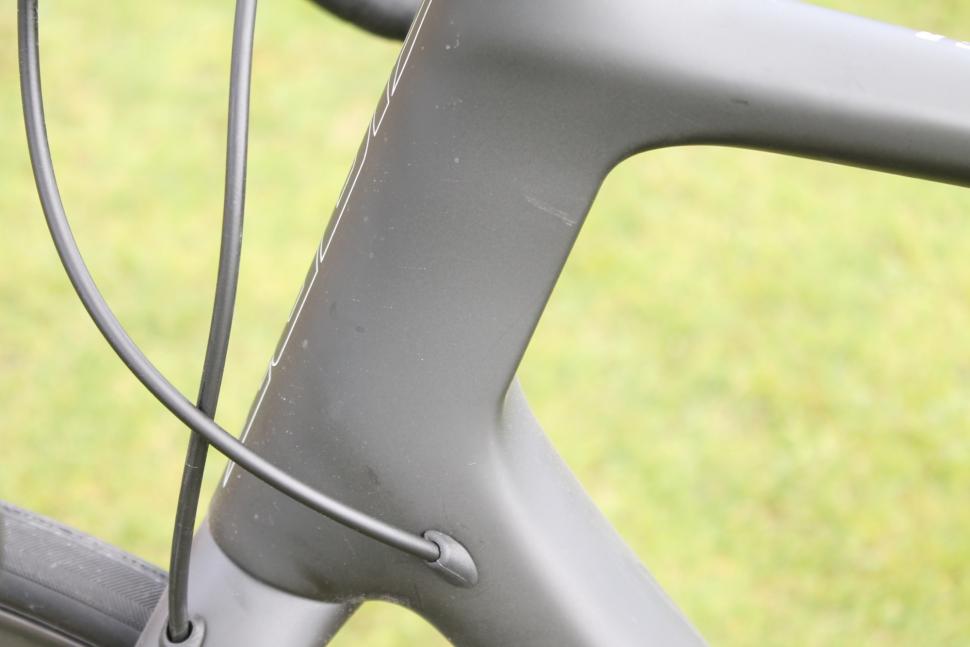
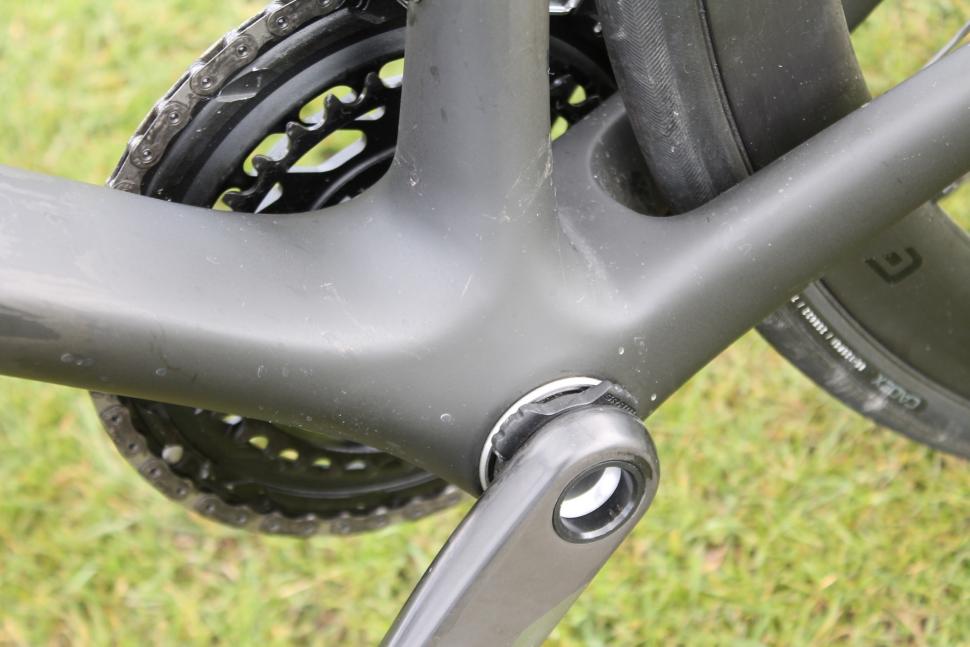


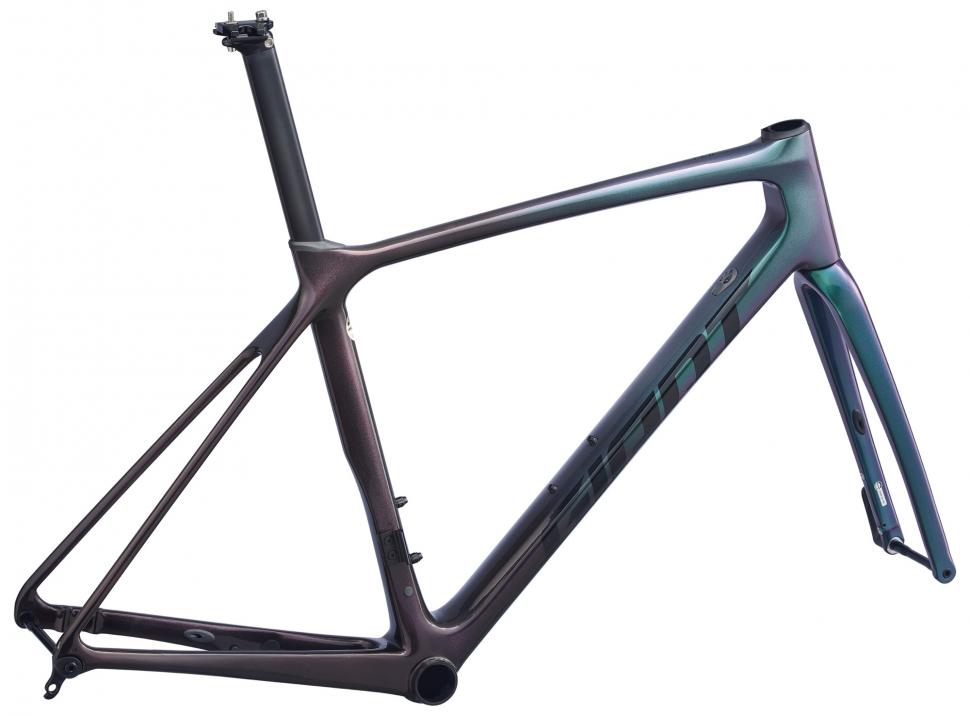
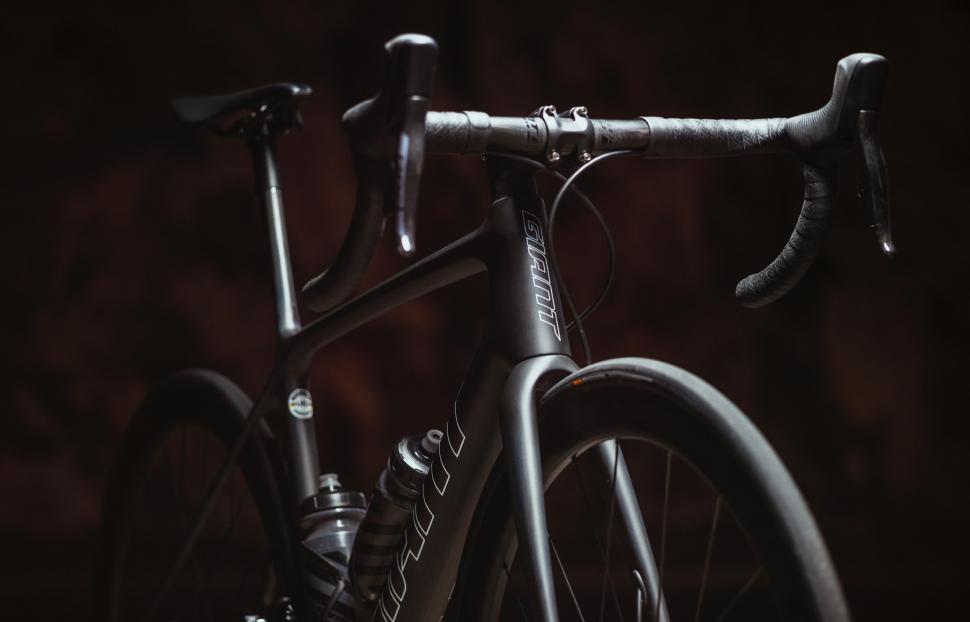
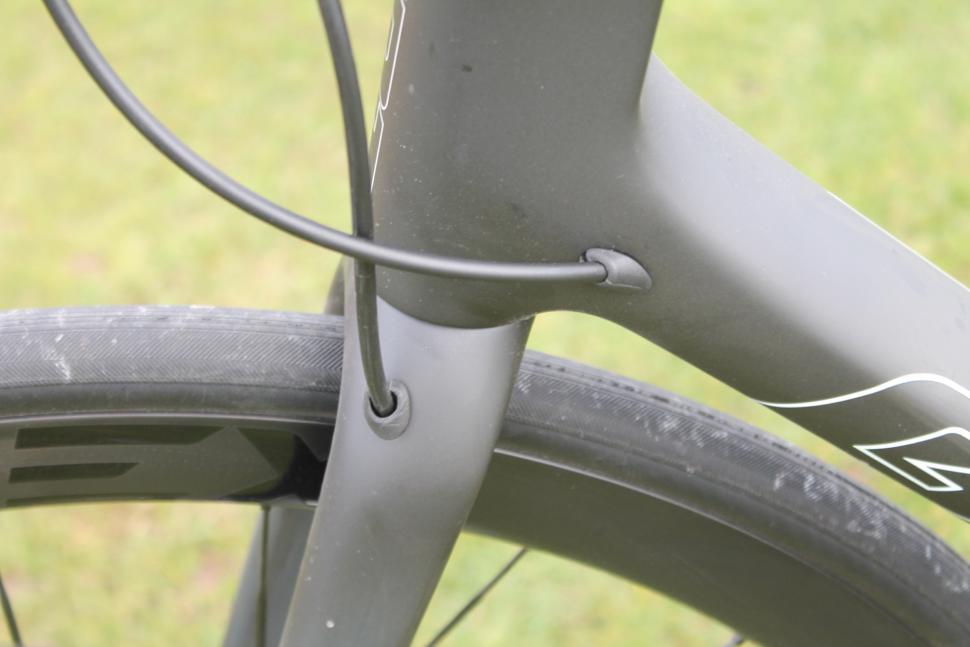

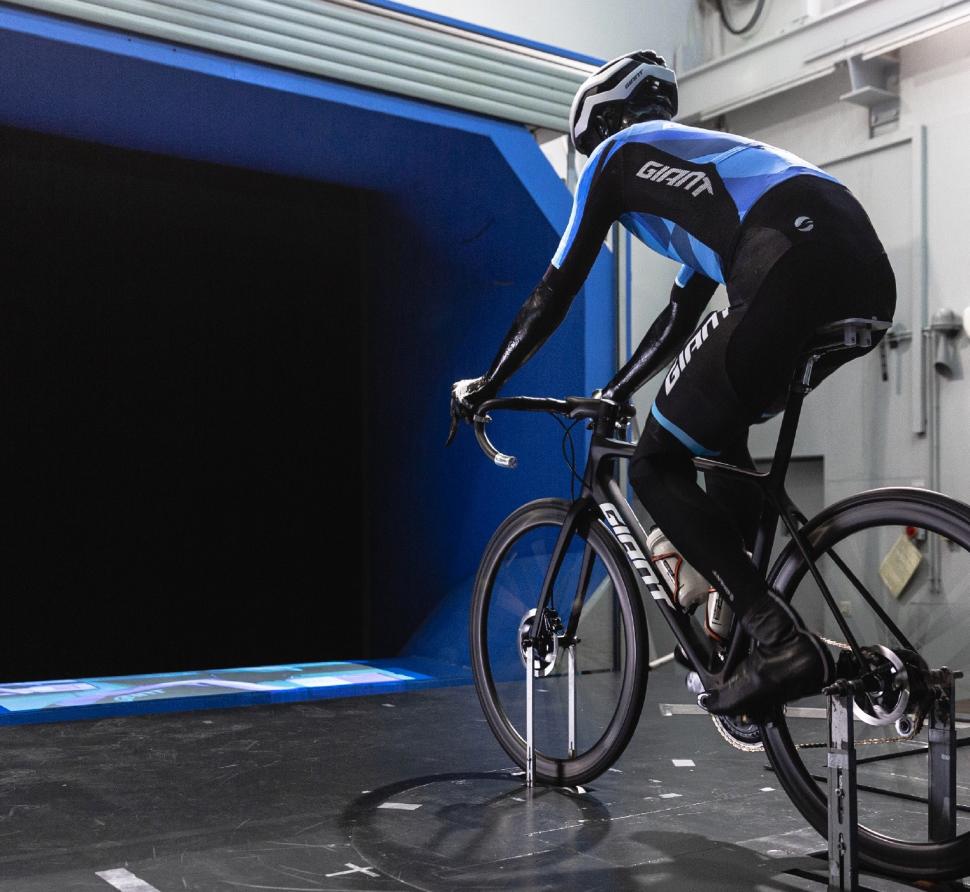


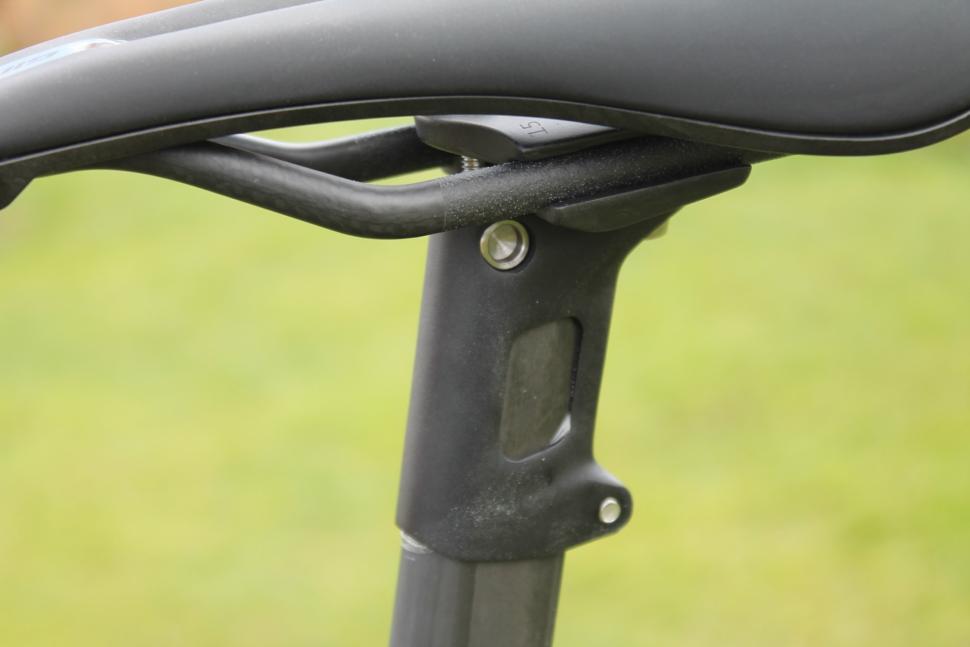
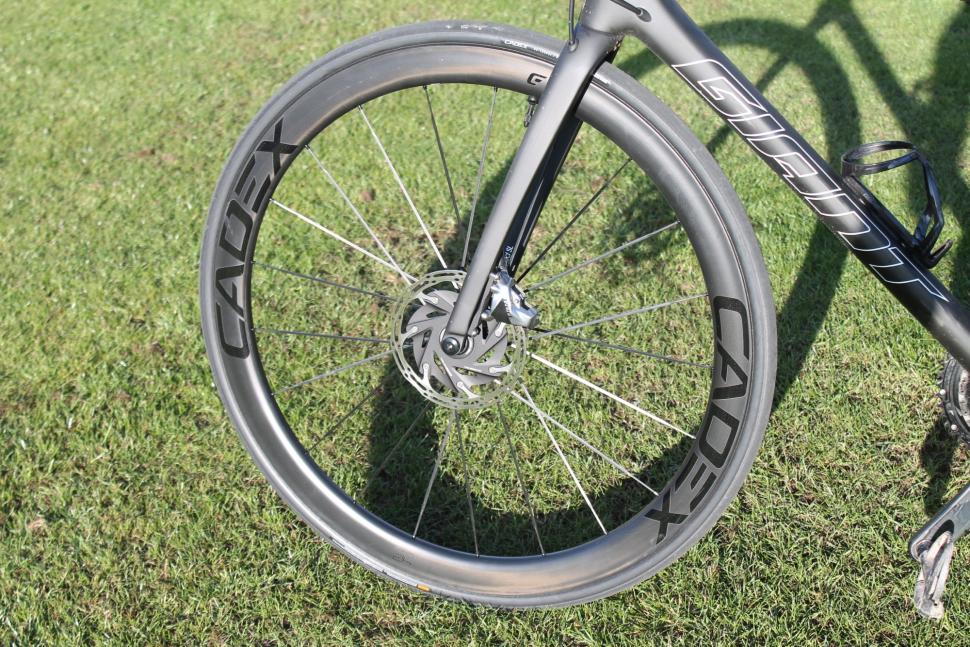


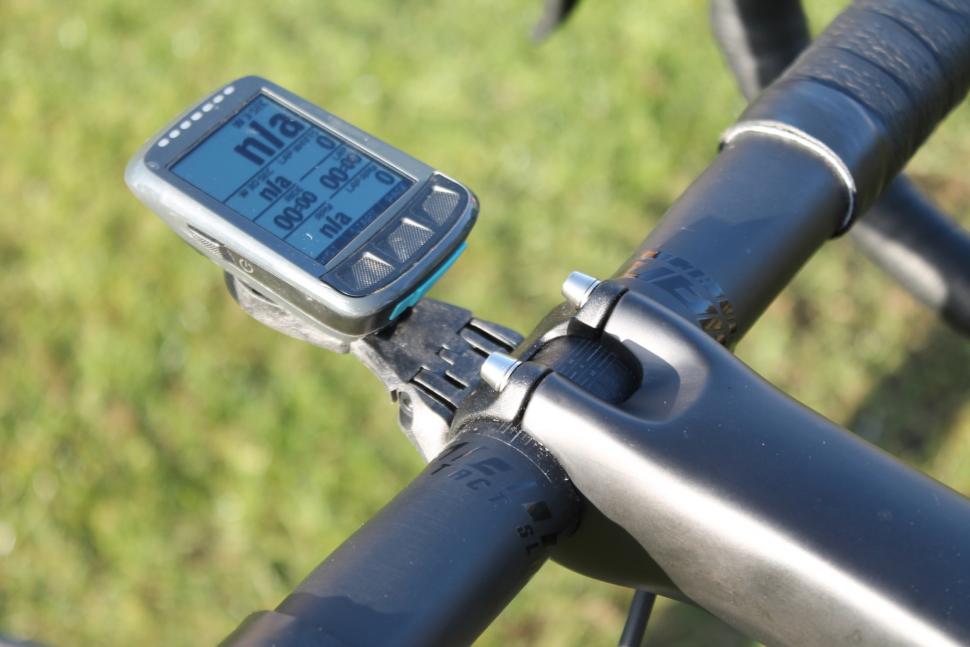

































Add new comment
10 comments
Oh look, another black plastic bike with looks only its mother could love.
It's a no from me.
Thank you for sharing this critical information. I know my life is much improved by it.
Giant launch 2021 TCR Advanced – the “fastest TCR ever”
Don't they say that every year
If it was all true, bikes would be as fast as Cars with no effort at all.
Bit of a surprise to see exposed cables on a new top end release like this nowadays.
Apparently a conscious choice. From the recent cycletips article about the TCR by James Huang here https://cyclingtips.com/2020/04/2021-giant-tcr-advanced-sl-disc-first-ride-review-an-aero-evolution/
I thought the same, seems a missed opportunity especially given that they're running SRAM.
Only an opportunity if their goal was aero-performance over 'efficiency' (in their more holistic sense) I guess.
One of the main advantages for the average punter of having non-integrated cables is making it a bit easier to pack the bike when you want to travel with it, but with that enormous fixed seatpost I doubt you can get one of these in a bike box anyway.
One of the main advantages ? Personally i'd doubt that to be honest.. even if the average Joe actually used a bike box with any regularity/ever. Always found the less random cables sticking out the easier when packing myself and there's not much contest when maintainence is brought into the picture IMO. Integrated stuff looks pretty though..
Integrated post might indeed make things slightly more interesting though depending on size, bike box etc, but there's plenty of boxes that are designed to cope - if you take a size 63 frame with a massive bar drop than that could be fun.... there's a reason they stick to them though, theoretical extra hassle and all.
I love TCR's but as others have pointed out - it's time that Giant invested some R&D in this aging frame to clean up the cockpit area and make the front-end integrated/cable free. Having a disc-brake cable that enters the top of the fork leg only to exit at the bottom of the fork leg is just lazy. Sure it might be more practical to service bikes with non-integrated cable setups, but MTB's have been using plug-n-play hydraulic cables in dropper posts for years and I don't see why this tech can't be applied to road bikes with hydraulic disc brakes. Come on Giant, give us what we all want and make the next TCR unbeatable!!